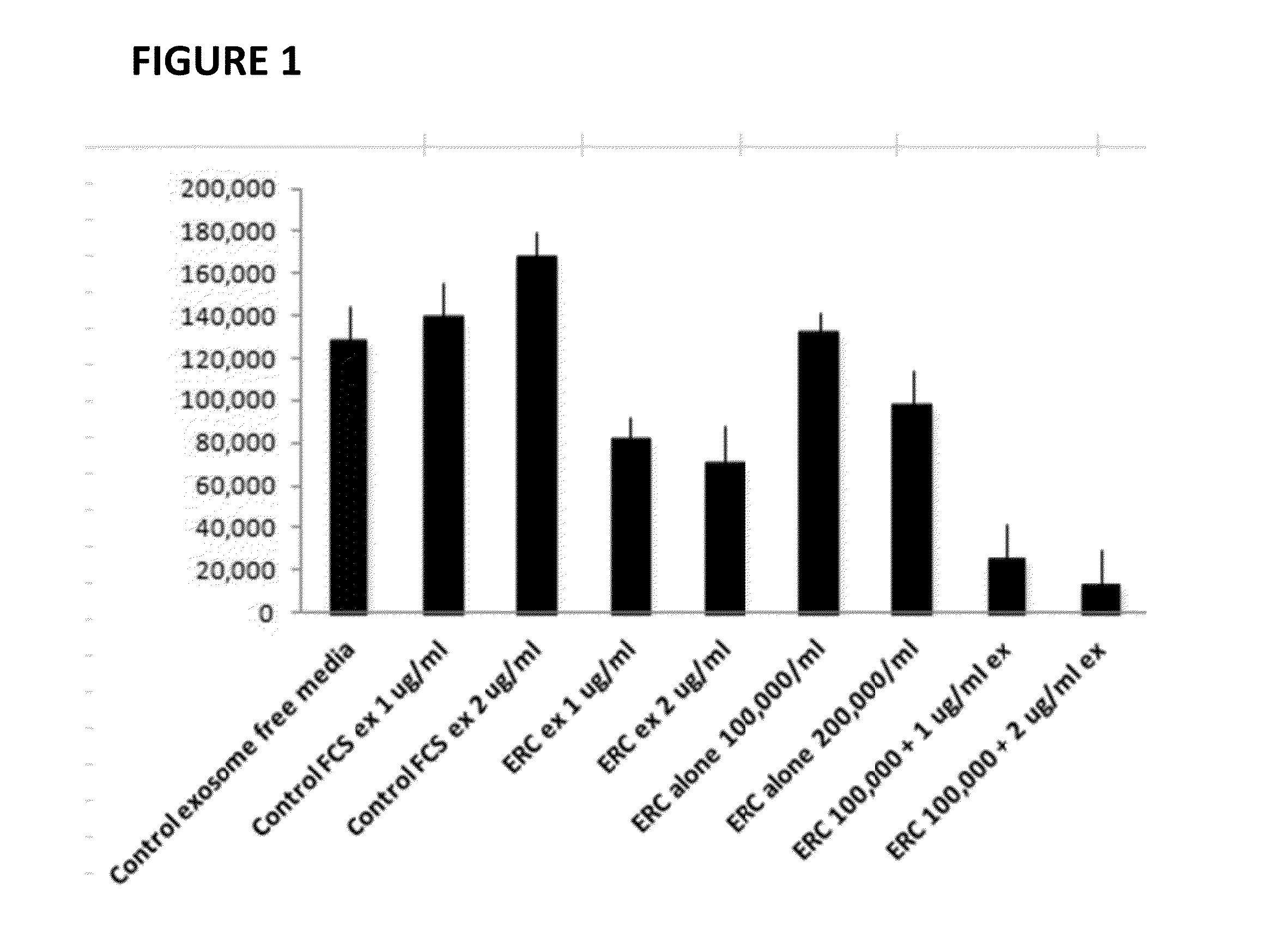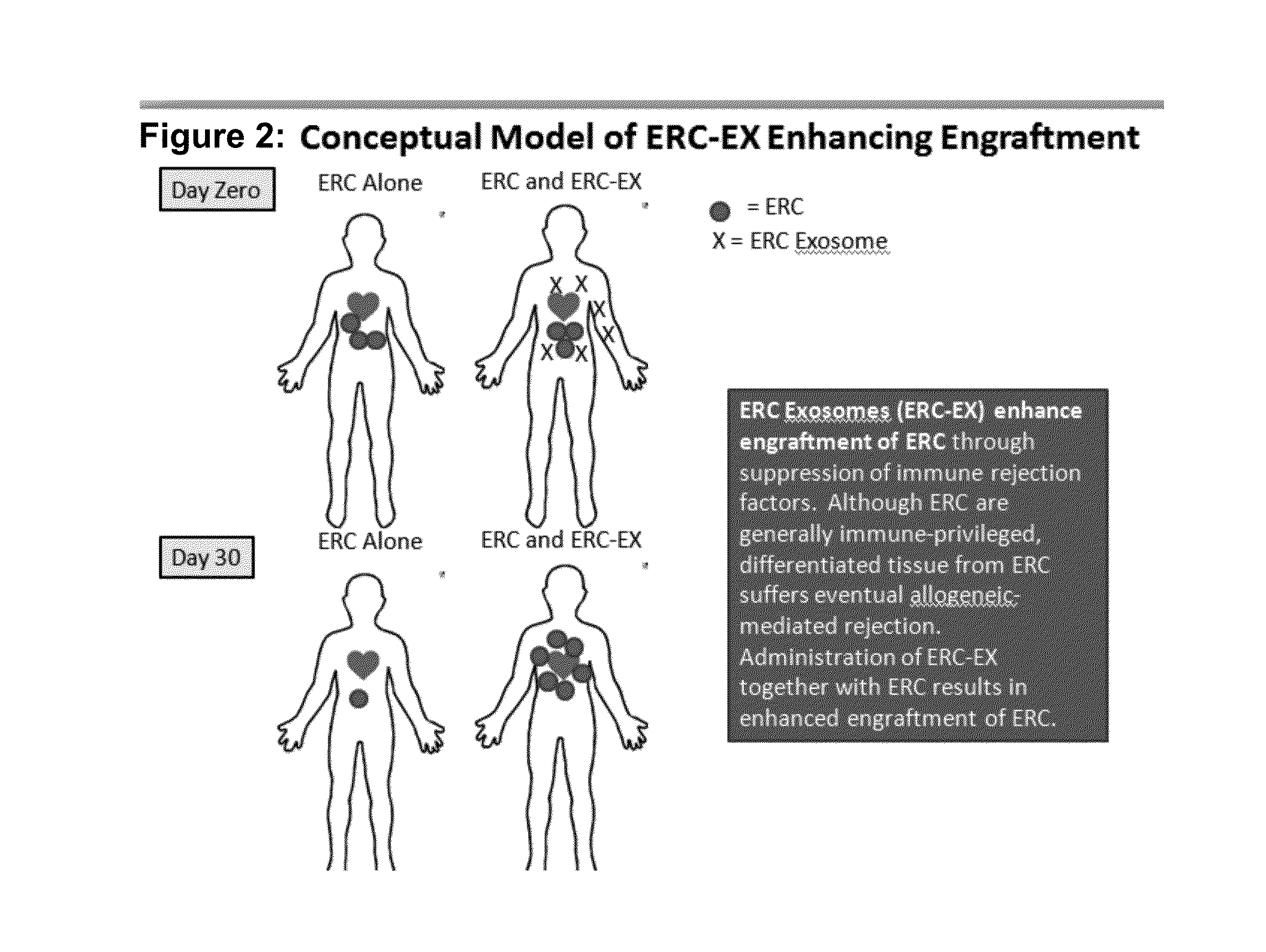Therapeutic immune modulation by stem cell secreted exosomes
- Summary
- Abstract
- Description
- Claims
- Application Information
AI Technical Summary
Benefits of technology
Problems solved by technology
Method used
Image
Examples
example 1
ERC Exosomes Inhibit MLR and Augment ERC Ability to Inhibit MLR
[0024]Exosome Purification. Exosomes were prepared from the cell culture supernatant of day 4 ERC cultures by differential centrifugation. Briefly, recovered culture supernatant was subjected to three successive centrifugations at 300 g (5 min), 1,200 g (20 min), and 10,000 g (30 min) to eliminate cells and debris, followed by centrifugation for 1 h at 100,000 g. To remove excess serum proteins, the exosome pellet was washed with a large volume of PBS, centrifuged at 100,000 g for 1 h, and finally resuspended in 120 ul of PBS for further studies. The exosomes were quantified by a micro Bradford protein assay (Bio-Rad). Each batch was standardized by protein content, Fetal calf serum exosomes were prepared using the same method.
[0025]Tissue Culture Peripheral blood mononuclear cells (PBMC) were isolated from 5 ml of blood by Ficoll density gradient (Sigman-Aldrich) utilizing two HLA-incompatible donors. Cells were washed ...
example 2
ERC Exosomes Enhance In Vivo Engraftment of ERC in Immune Competent BALB / c Mice
[0026]The previous experiments suggest that addition of ERC-Exosomes to a mixed lymphocyte reaction (MLR) enhances ability of the ERC cell to decrease ongoing immune response in vitro. Accordingly, we sought to determine whether co-administration of exosomes may enhance engraftment of ERC. As seen in Table 1, administration of 40 and 80 micrograms of ERC-Exosomes per mouse was sufficient to significantly enhance ERC engraftment.
TABLE 1Administration of ERC-EX Increases Human ERC Engraftmentin Immune Competent BALB / c MiceTreatment1 hr7 days14 days30 daysERC* 28 (±5)# 2 (±1)0 (±1)0 (±0)ERC + 10 ug ERC-32 (±7) 5 (±4)4 (±3)3 (±3)EXERC + 20 ug ERC-25 (±9)18 (±4)6 (±5)4 (±1)EXERC + 40 ug ERC-26 (±5)22 (±1)19 (±2) 17 (±3) EXERC + 80 ug ERC-33 (±3)24 (±4)25 (±4) 19 (±5) EX*ERC were administered into the gastrocnemius muscle at a concentration of 100,000 cells.#Detection of human cells was performed using mouse an...
PUM
| Property | Measurement | Unit |
|---|---|---|
| Time | aaaaa | aaaaa |
| Size | aaaaa | aaaaa |
| Biological properties | aaaaa | aaaaa |
Abstract
Description
Claims
Application Information
 Login to View More
Login to View More - R&D
- Intellectual Property
- Life Sciences
- Materials
- Tech Scout
- Unparalleled Data Quality
- Higher Quality Content
- 60% Fewer Hallucinations
Browse by: Latest US Patents, China's latest patents, Technical Efficacy Thesaurus, Application Domain, Technology Topic, Popular Technical Reports.
© 2025 PatSnap. All rights reserved.Legal|Privacy policy|Modern Slavery Act Transparency Statement|Sitemap|About US| Contact US: help@patsnap.com


